If you’re an engineer designing an industrial fluid system, selecting municipal infrastructure components, or developing OEM plumbing devices, the materials you select for the valves can make or break the integrity of your system. While the nature of the valve—ball, gate, globe, etc.—determines that it will regulate flow, what it’s made of will dictate how it will stand up to pressure, corrosion, and temperature over time.
Each application requires different material qualities. Inadequate choice will lead to valve failure, system leakage, costly downtime, or even create health hazards. Due to this, determination of prevalent valve materials—and their correct application—is crucial to engineers, specifiers, and purchasers.
In this article, we’ll explore the most widely used materials in valve manufacturing, their key characteristics, and how to choose them based on the unique demands of your application. This article focuses solely on material science and application selection, with no repetition of topics like certifications, sourcing strategy, or valve type comparisons.
1. Why Valve Material Selection Is Crucial?
Before describing specific material types, remember why material is absolutely essential for valve performance.
1) Chemical Compatibility and Corrosion Resistance
Valves are exposed to corrosive fluid or harsh cleaning chemicals. The improper material will deteriorate, crack, or emit poisonous chemicals with time—especially in:
- Water treatment plants
- Chemical processing plants
- Food and liquid systems
- Medical or pharmaceutical applications
For example, a plain carbon steel valve in seawater would be rusted within a few months, yet the equivalent stainless steel or bronze valve would endure decades.
2) Resistance to Mechanical and Thermal Stress
External force, internal pressure, and thermal expansion and contraction are the stresses valves endure. Cryogenic, high-pressure steam, or high-cycling conditions merely add emphasis to this requirement.
- Low-pressure water = plastic or brass, would be sufficient
- High-pressure superheated steam = carbon steel or ductile iron is essential
3) Compliance with Industry Standards
Special materials may be required by regulated industries:
- Potable water valves: stainless steel or lead-free brass certified by NSF
- Food industry: clean, smooth, 316L stainless steel
- Hazardous gas: explosion-proof materials, spark-free alloys
- Marine: nickel-aluminum-bronze or bronze for salt resistance
In short, your material of choice must meet technical demands as well as legal requirements.
2. General Valve Materials and Their Properties
We now consider the most common materials used by plumbing valves manufacturers, divided into metals, plastics, and specialty.
1) Brass
Brass is used extensively in residential water plumbing, HVAC, and general water distribution.
- Composition: Copper + Zinc (leaded or lead-free)
- Temperature range: -20°C to ~120°C
- Pressure rating: to 600 psi (design dependent)
Advantages:
- Easy to machine and cast
- Resistant to mild corrosion
- Low cost, easy availability
Disadvantages:
- Not for use in contact with aggressive chemicals or acidic fluids
- Corrosion in highly chlorinated water
- Lead content must be controlled in drinking water (NSF 372)
Applications: Angle valves, hose bibs, shut-off valves, radiator valves
2) Bronze
Stronger and more corrosion resistant than brass, especially for marine and exterior exposures.
- Compositional: Copper + Tin (phosphorus, silicon, or aluminum forms)
- Temperature range: -40°C to ~200°C
Advantages:
- High seawater and atmospheric corrosion resistance
- Extremely high mechanical strength
- Lifetime in marine or exterior applications is long
Disadvantages:
- High cost relative to brass
- High weight
- Less machinable than stainless steel
Applications: Shipboard piping, sprinkler system, marine valve
3) Stainless Steel
Stainless steel is an extremely strong, corrosion-resistant material applicable to extreme environments.
- Common grades: 304, 316, 316L, Duplex
- Operating range: -50°C up to more than 500°C (grade dependent)
Advantages:
- Corrosion resistance to a broad chemistry range
- Easy to clean and sanitary
- High-pressure rating and durable
- Food, pharma, and potable water compliance
Disadvantages:
- Costly
- Severe stress corrosion cracking in some chemicals (e.g., chlorides)
- Heavier than plastics or aluminum
Applications: Food processing, drugs, petrochemical plants, water treatment plants
4) Carbon Steel
Carbon steel is economical with high strength and little corrosion protection.
- Temperature range: -30°C to ~450°C
- Pressure rating: High (ANSI Class 600 or more)
Advantages:
- Suitable for high-pressure steam and oil service
- High strength-to-price ratio
- Streamline the machining and welding process
Disadvantages:
- Minimum or no corrosion protection in the uncoated or unlined state
- Does not comply with proper resistance to be used in corrosive service or in potable water
Applications: Steam valve, transmission pipe for gas, manufacturing process equipment
5) Cast Iron and Ductile Iron
Ductile iron and cast iron are used on iron valves for infrastructure and large diameter pipe for economy and strength.
- Cast iron is hard but brittle
- Ductile iron with magnesium added for greater impact strength
Advantages:
- Low price at big diameters
- High building strength
- Good vibration damping
Disadvantages:
- Susceptible to corrosion—usually lined or coated
- Cannot be used where there is acid or salt water present
Applications: Municipal water, HVAC, fire-protection piping
6) PVC and CPVC
PVC (Polyvinyl Chloride) and CPVC (Chlorinated PVC) are lightweight plastics ideally suited for low-pressure services.
Temperature range:
- PVC: 0°C to ~60°C
- CPVC: Up to ~95°C
Advantages:
- Corrosion-resistance
- Light weight and simple to install
- Non-toxic to potable water (if NSF certified)

Disadvantages:
- Low temperature and pressure ratings
- Brittle when used in cold or UV-light exposed applications
Applications: Residential plumbing, pool system, laboratory water, irrigation
7) PTFE, PFA, and Lined Materials
PTFE (Teflon®), PFA, and other fluoroplastics are utilized for chemical resistance or as metal valve liners.
Advantages:
- Highly chemically inert
- Low friction, non-stick
- Ultra-pure and sterile process is certified
Disadvantages:
- Structurally not strong on their own
- Expensive
- Poor pressure resistance unless metal reinforced
Applications: Chemical processing, semiconductor fluid control, acid lines
3. Choosing the Right Material for Your Application
With all these on offer, how do you choose the right one? Read on for the step-by-step guide.
1) Investigate the Media
Listen to what you are passing through the valve:
- Pure water → Brass, Stainless Steel, PVC
- Seawater → Bronze or Duplex Stainless
- Acid or bases → Hastelloy-lined or PTFE
- Food products → 316L Stainless Steel only
Chemical compatibility charts are helpful, but cross-check the valve manufacturer’s recommendations too.
2) Consider Environmental Conditions
Will the valve be exposed to:
- UV, rain, or salt spray? Bronze or stainless coat.
- Exposed underground? Epoxy-lined ductile iron.
- Cleanroom or sterile operation? 316L stainless or PFA-lined materials.
3) Consider Operating Pressure and Temperature
Select materials to equal your system’s highest pressure and temperature:
- PVC = low pressure/temp
- Stainless/carbon steel = high temp/pressure
- Ductile iron = tough but have to be lined
Overspecifying costs money; underspecifying requires failure.
4) Meet Regulatory and Project Specifications
Some systems need to be to standard:
- Potable water → NSF 61
- Food & beverage → 3-A or FDA
- Explosive conditions → ATEX, non-sparking materials
Work backwards from your compliance requirements to determine material constraints.
5) Optimize Cost and Lifecycle Value
The best-cost material to use on the right valve isn’t always the cheapest cost of maintenance and shortest life before obsolescence.
You must ask yourself:
- How many cycles per year does this valve undergo?
- Maintenance is going to be a snap in how it’s installed, isn’t it?
- Cost of failure and cost of downtime?
Sometimes and rarely, more initial cost = lower lifecycle cost.
4. Conclusion
Material choice in valve manufacturing isn’t a question of what one has on hand—it’s a question of what is best. With all the metals, plastics, and specialty resins available today, there’s no excuse to be a “one-size-fits-all” person.
Whether specifying for a chemical plant, a clean water distribution system, or an OEM product line, specifying a correct material upfront ensures:
- System life
- Safety of operation
- Conformance with the law
- Lower cost of total ownership



